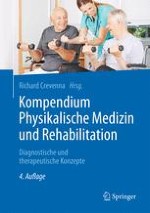Zusammenfassung
Die physikalische Therapie als konservative, nicht invasive Therapieform und ohne Nebenwirkung stellt den ersten Therapieansatz bei Harn- und Stuhlinkontinenz in den nationalen und internationalen Empfehlungen dar. Die Evidenzlage ist gut für Beckenbodentraining, sowie für Miktions- und Toilettentrainingsinterventionen wie auch elektrotherapeutische Maßnahmen. Biofeedback ermöglicht eine gezielte Wahrnehmungsschulung und kann auch zur Unterstützung der Eigenkompetenz und Verhaltensmodifikation gut eingesetzt werden. Wie bei vielen Methoden der physikalischen Medizin ist die Wirkung multimodal, sodass die Studienlage noch sehr uneinheitlich hinsichtlich der Effektivität dieses Therapiemittels ist. Neue, interessante Therapieoptionen bieten die funktionelle Elektrostimulation in ihrer Form als mini invasive Neuromodulation.











